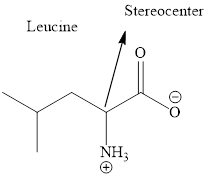
Concept explainers
(a)
Interpretation: Without any stereochemistry, the expected aldol addition product for the given
Concept Introduction:
Aldol addition:
When an aldehyde is treated with aqueous sodium hydroxide, the major product has the aldehydic group and a hydroxyl group. It is therefore called an “aldol” (“ald” for aldehyde and “ol” for alcohol). In the product, it is important to note that hydroxy group should be located in the
Example:

(b)
Interpretation: The all possible stereoisomers for the product obtained in the subpart (a) have to be drawn.
Concept Introduction:
Stereocenters:
It refers to the carbon that have four different groups attached to it. It is also known as chiral centre.
Stereoisomers
The stereoisomers are the compounds with same molecular formula but with different spatial arrangement of atoms.
Example:
The stereoisomers of Leucine:

Finding the number of possible stereoisomers:
The number of stereocenters in the compound has to be considered as ‘n’.
Then the possible number of stereoisomers of the compound should be given using the expression--
Example:

The maximum number of stereoisomers for
Where,
So, a maximum of two stereoisomers are possible for
The stereoisomers of

Want to see the full answer?
Check out a sample textbook solution
Chapter 21 Solutions
ORGANIC CHEMISTRY-NEXTGEN+BOX (2 SEM.)
 ChemistryChemistryISBN:9781305957404Author:Steven S. Zumdahl, Susan A. Zumdahl, Donald J. DeCostePublisher:Cengage Learning
ChemistryChemistryISBN:9781305957404Author:Steven S. Zumdahl, Susan A. Zumdahl, Donald J. DeCostePublisher:Cengage Learning ChemistryChemistryISBN:9781259911156Author:Raymond Chang Dr., Jason Overby ProfessorPublisher:McGraw-Hill Education
ChemistryChemistryISBN:9781259911156Author:Raymond Chang Dr., Jason Overby ProfessorPublisher:McGraw-Hill Education Principles of Instrumental AnalysisChemistryISBN:9781305577213Author:Douglas A. Skoog, F. James Holler, Stanley R. CrouchPublisher:Cengage Learning
Principles of Instrumental AnalysisChemistryISBN:9781305577213Author:Douglas A. Skoog, F. James Holler, Stanley R. CrouchPublisher:Cengage Learning Organic ChemistryChemistryISBN:9780078021558Author:Janice Gorzynski Smith Dr.Publisher:McGraw-Hill Education
Organic ChemistryChemistryISBN:9780078021558Author:Janice Gorzynski Smith Dr.Publisher:McGraw-Hill Education Chemistry: Principles and ReactionsChemistryISBN:9781305079373Author:William L. Masterton, Cecile N. HurleyPublisher:Cengage Learning
Chemistry: Principles and ReactionsChemistryISBN:9781305079373Author:William L. Masterton, Cecile N. HurleyPublisher:Cengage Learning Elementary Principles of Chemical Processes, Bind...ChemistryISBN:9781118431221Author:Richard M. Felder, Ronald W. Rousseau, Lisa G. BullardPublisher:WILEY
Elementary Principles of Chemical Processes, Bind...ChemistryISBN:9781118431221Author:Richard M. Felder, Ronald W. Rousseau, Lisa G. BullardPublisher:WILEY





